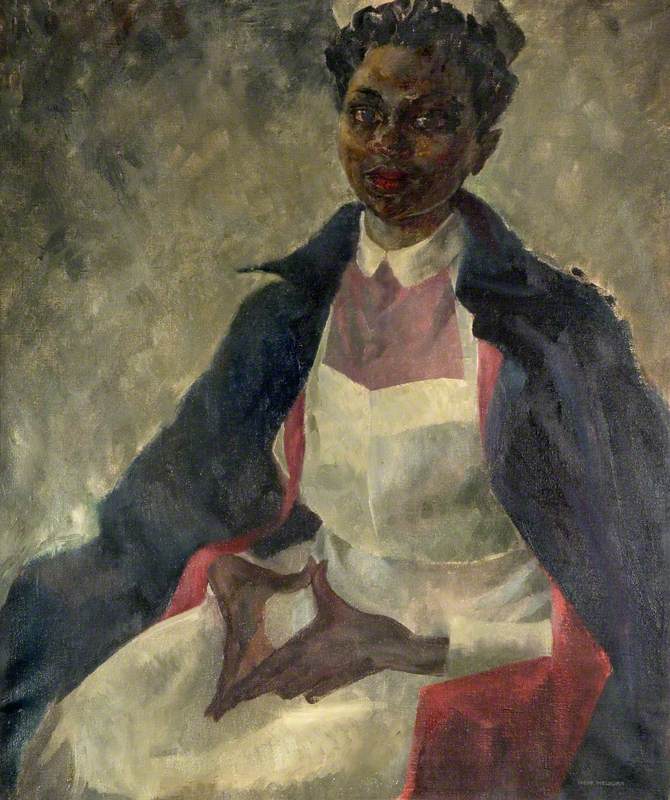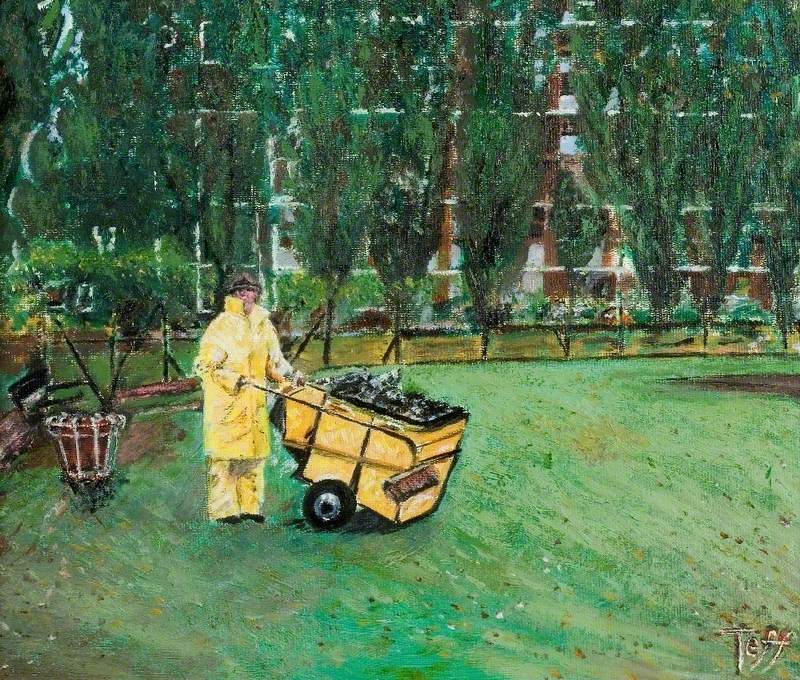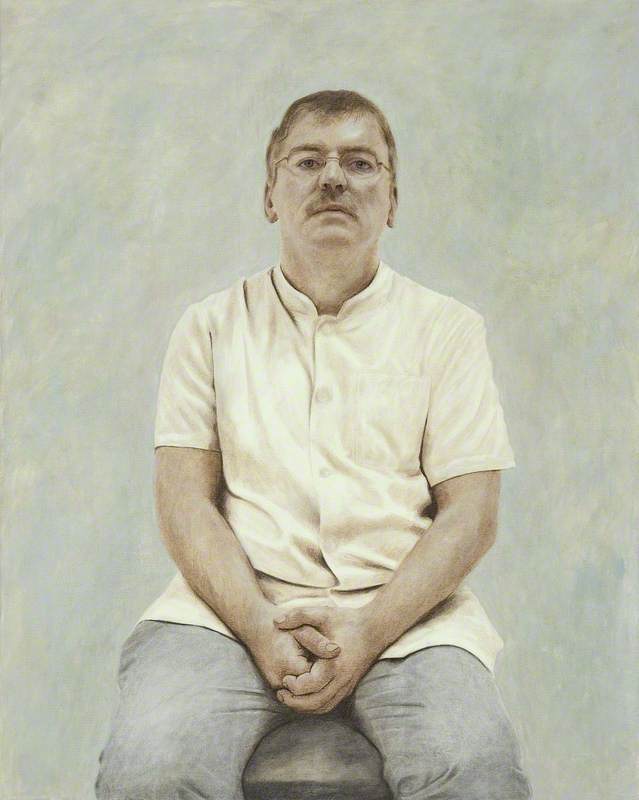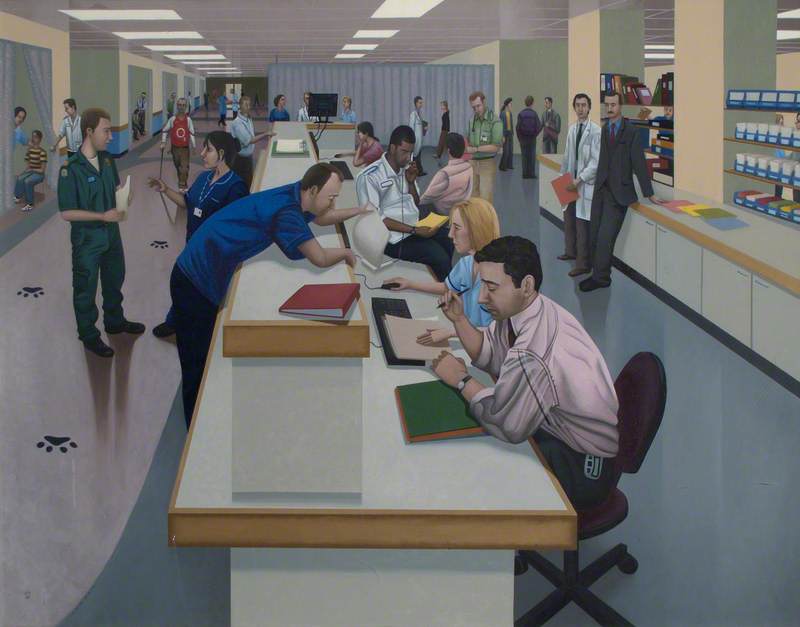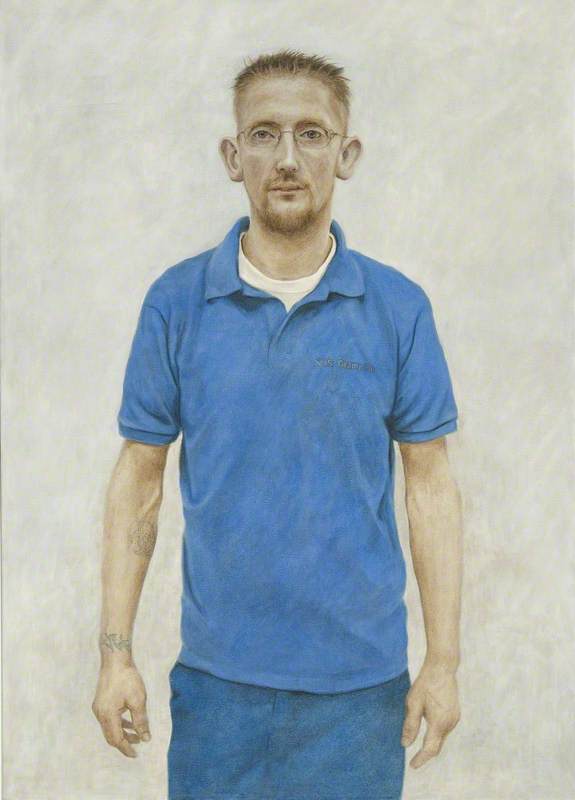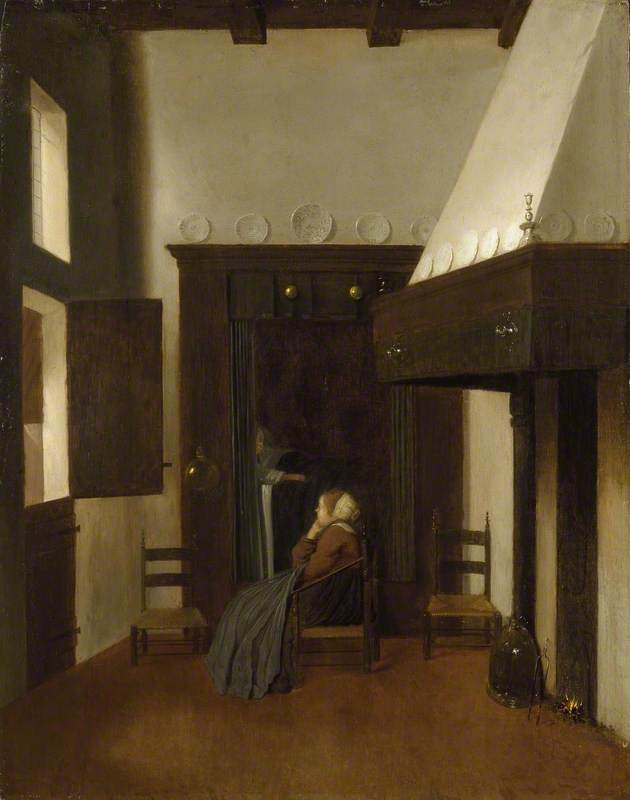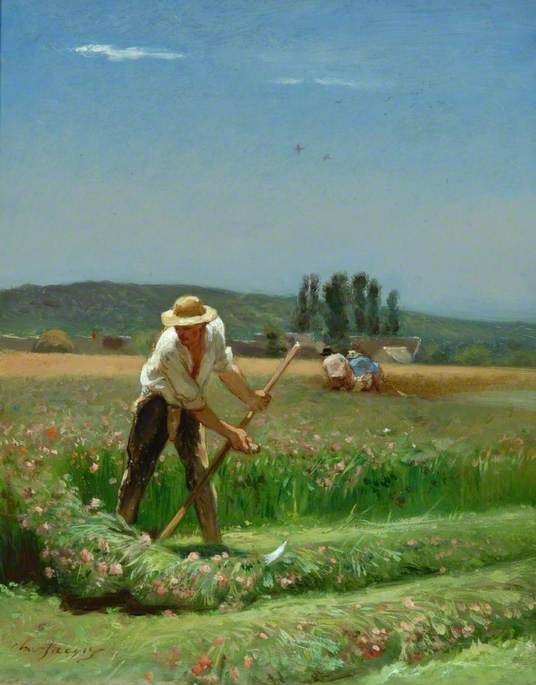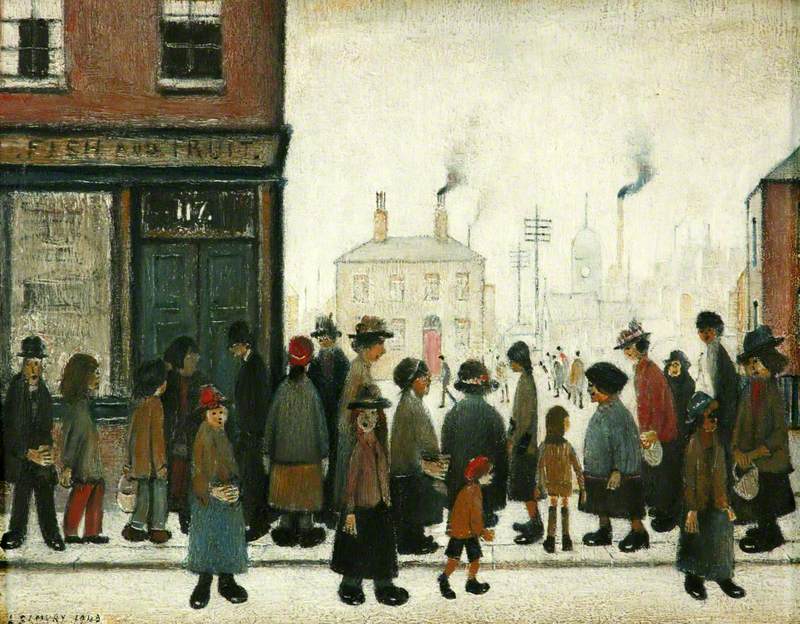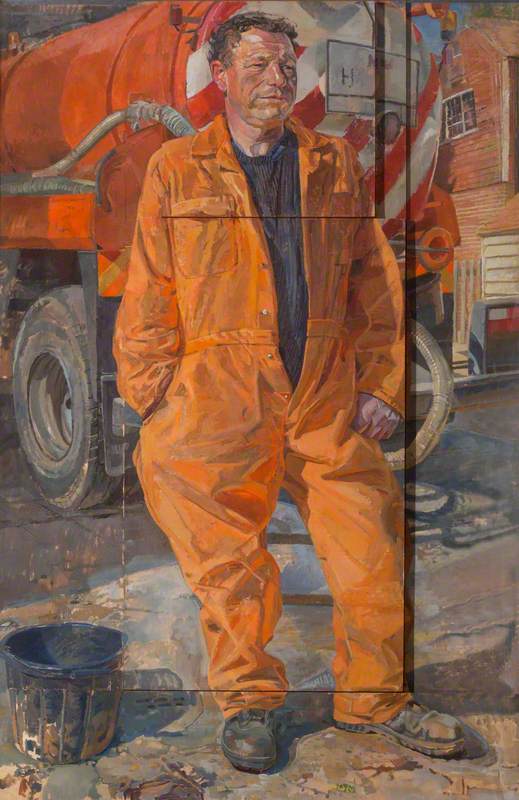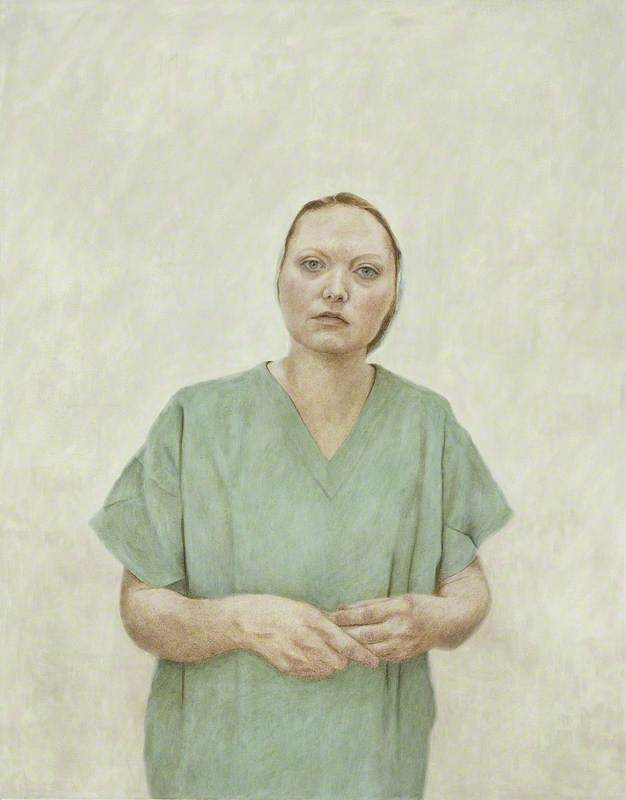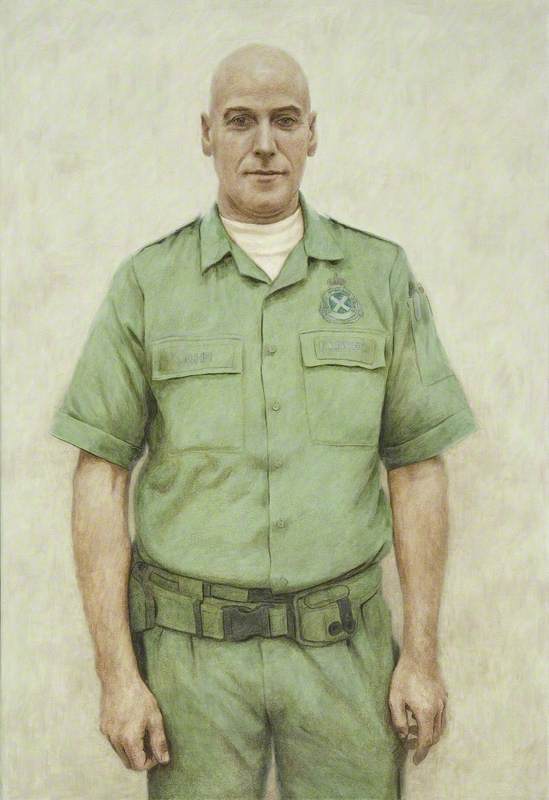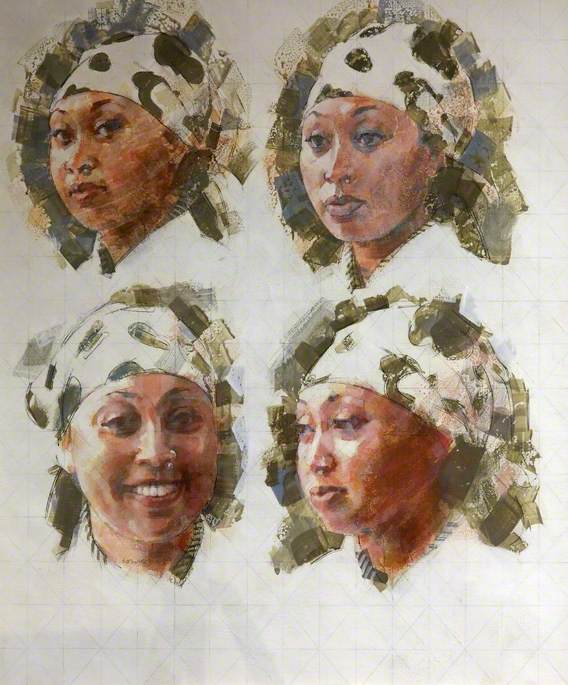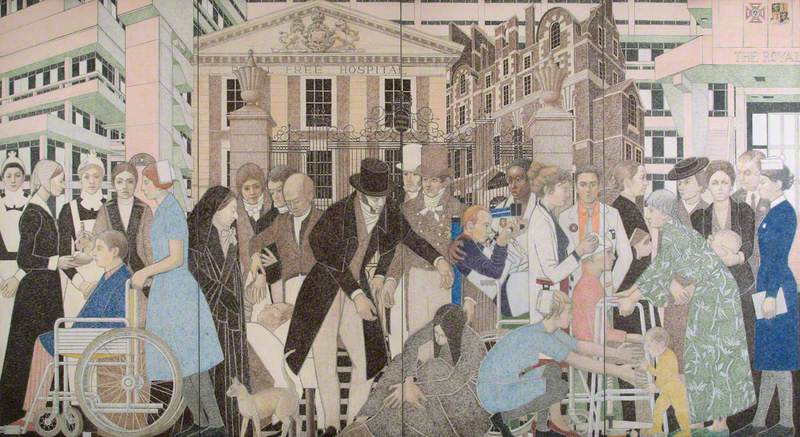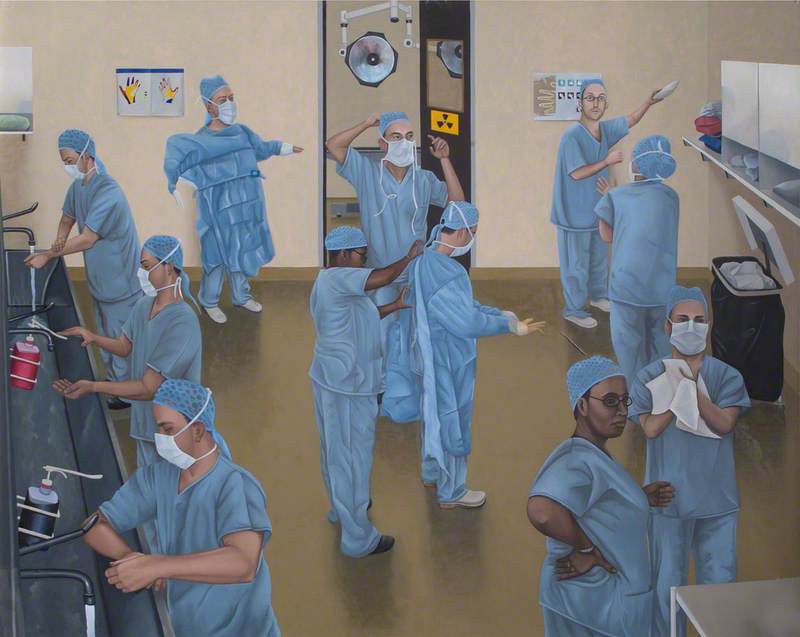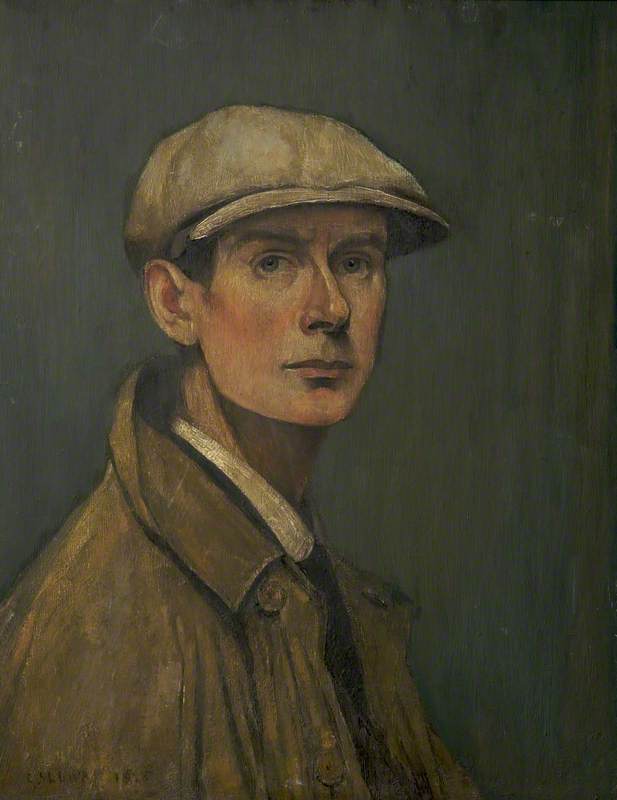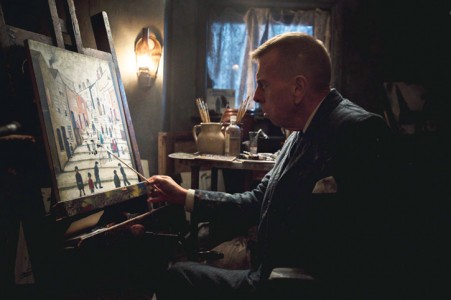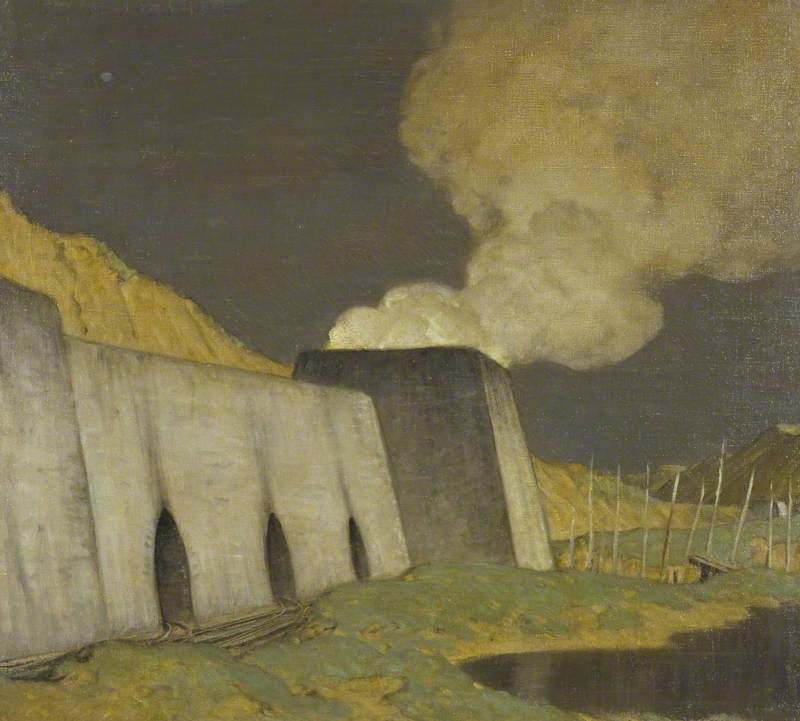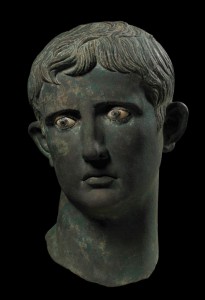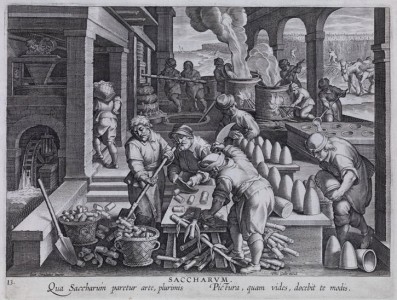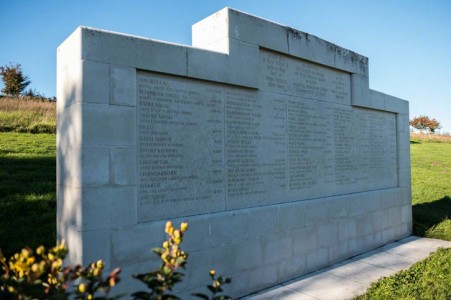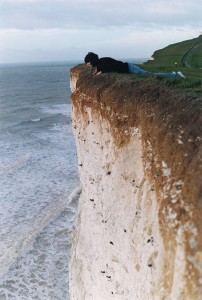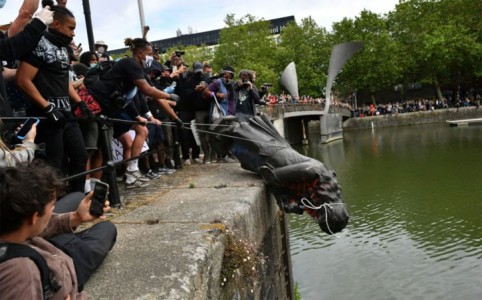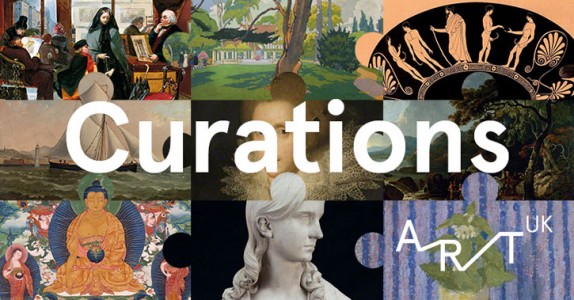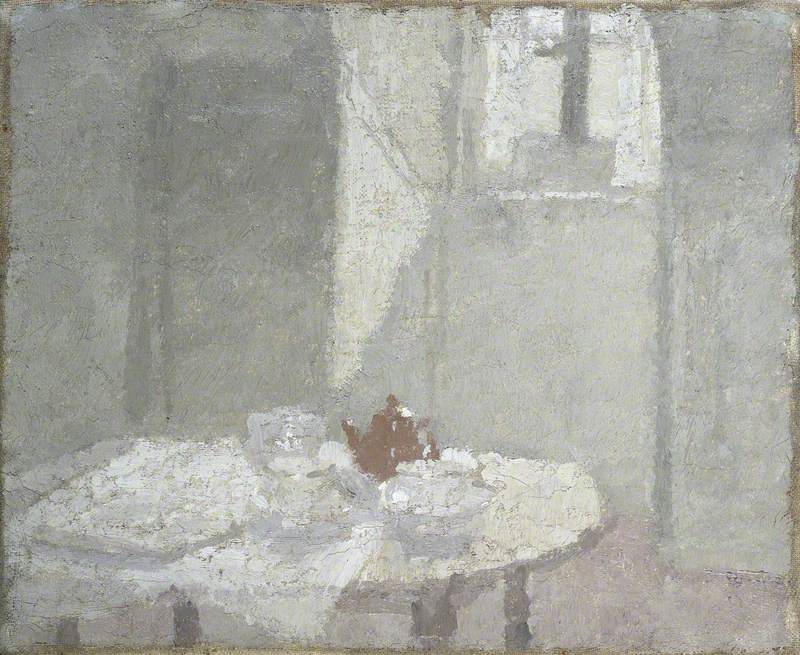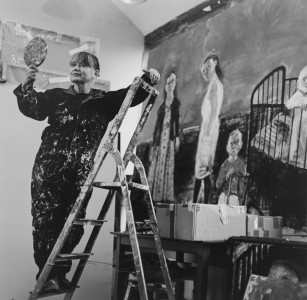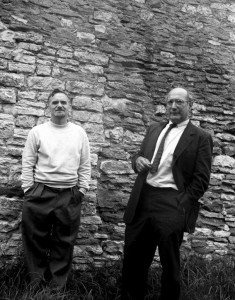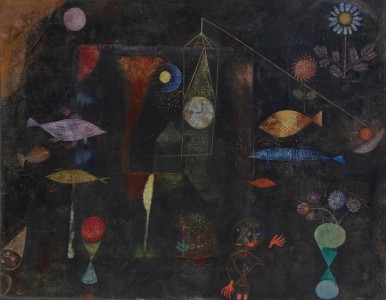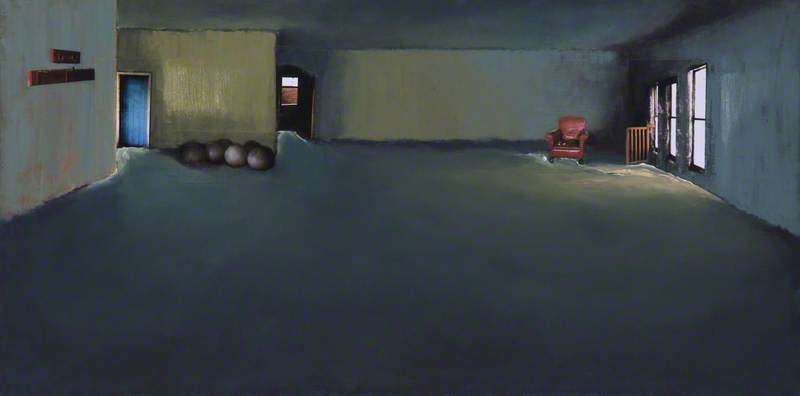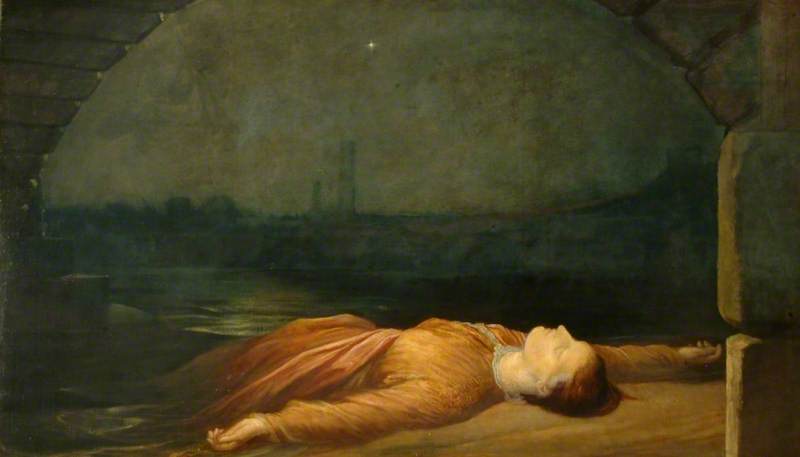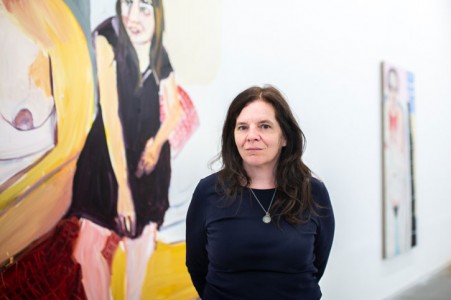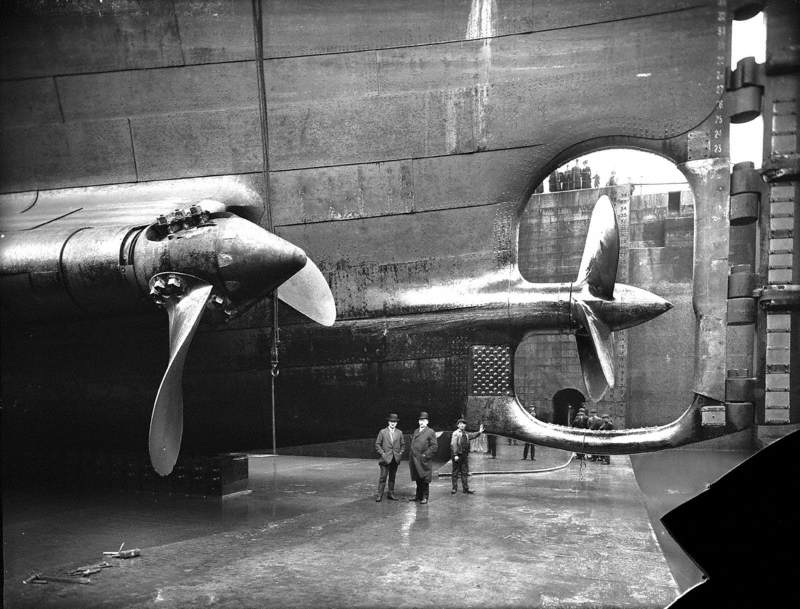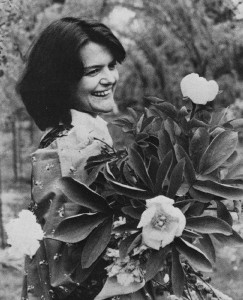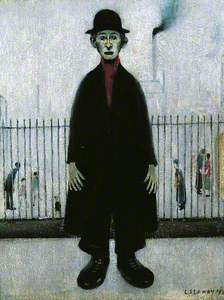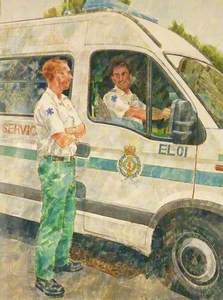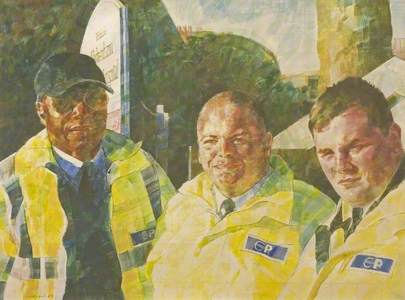In March of this year, in the wake of the COVID-19 outbreak, many public sector employees, problematically defined as 'low-skilled' workers, overnight became 'key workers.' Typically low-paid NHS staff, transport workers, cleaners, social and health carers, supermarket staff among other professions were rightfully pushed to the forefront of headlines and conversations. Rebranded as undervalued heroes, they were awarded a long overdue thanks for keeping the UK running in a time of acute crisis.
Babs Davis and Kathy King, Seamstresses, and James, Cleaner
2001
John Michael Whiskerd (b.1932) 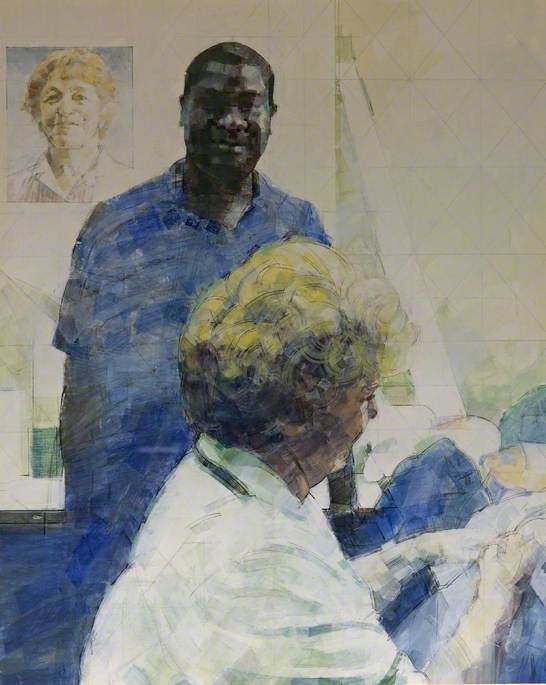
A radical shift in our priorities as a nation has changed our perceptions of those working in the public, or public-facing, sector. This shift has been so monumental, that in a July 2020 campaign called 'The New Frontline', Vogue dedicated its front covers to Naguis Horsford, a London Overground driver, Rachel Miller, a midwife, and Anisa Omar, a supermarket worker. These powerful covers replaced the usual airbrushed supermodels, thus raising the question as to why the lives of ordinary people aren't regularly represented in glossy magazines, or visual culture at large – with or without a pandemic.
The Editor of Vogue, Edward Enninful, wrote:
'Every so often a moment comes along that snaps everything into sharp focus... this chapter in history has seen society shift its attention on to some of the people in this country who are not usually afforded the spotlight.'
But Enninful's comment also invites us to reconsider art history in sharp focus. Centuries of tradition has resulted in our museums being predominately filled with secular portraits of the wealthy, aristocratic elite. In short, those members of the ruling classes who had enough wealth to be patrons of art and to immortalise themselves in oil painting and sculpture. In contrast, only a handful of artists and movements throughout history have turned their brushes towards those who, to repeat Enninful's words, couldn't afford the spotlight.
While in the seventeenth and eighteenth centuries artists often painted the everyday lives of ordinary folk – for example, the subject matters seen in Dutch genre painting or the satirical work of William Hogarth – it wasn't until the nineteenth century when artists painted with a clear and distinct political intent. French artists of the Barbizon School – Gustave Courbet and Jean-François Millet, among others – embraced realism as a means to focus on new formalistic painterly qualities, but also the lives of peasants and labourers.
The Gleaners
oil on canvas, copy of Jean-François Millet (1814–1875) 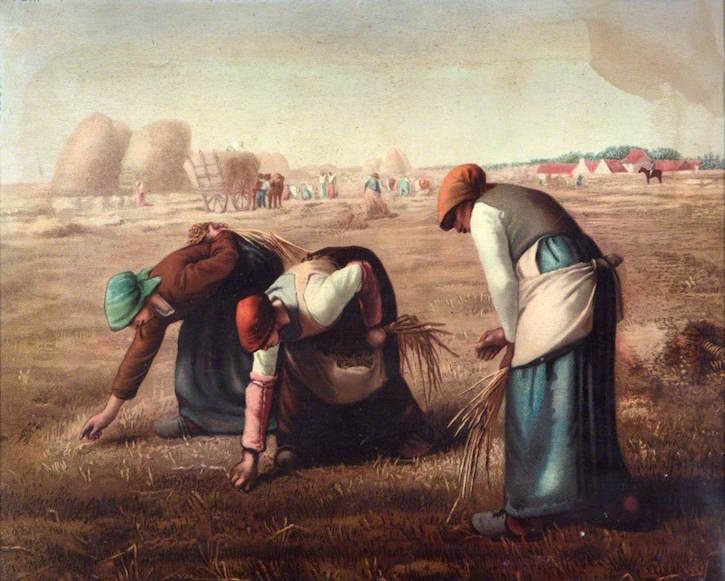
Millet's The Gleaners of 1857 encapsulated this shift in social values, which, when shown at the Salon of the same year, immediately received criticism and scorn from the upper echelons of French society. In the 1850s, to give representation to the working classes and monumentalise rural poverty was deemed vulgar and nothing short of revolutionary (which was a legitimate fear and regular occurrence in France at that time).
The artists of the Barbizon school had a point, one which remains pertinent in the twenty-first century. Shouldn't culture accommodate for representations of ordinary people, rather than the wealthiest, the most glamorous, and most privileged? To take this one step further, shouldn't opportunities to create and cultivate culture also be extended to those who come from the former rather than the latter?
Whether art and its associated museums, galleries and organisations are inherently elitist is a perennial question, one which is being confronted and addressed more rapidly in the age of social media (despite writing this article, I would certainly include myself in the category of 'privileged').
Continue scrolling to learn about a handful of artists in UK collections who elevated the everyday lives of labourers and key workers.
L. S. Lowry
One of the most loved (and most searched for artists on Art UK), Laurence Stephen Lowry (1887–1976) is famed for his 'matchstick' figures set among the post-war industrial landscapes of Salford and Greater Manchester.
Infused with melancholy but also compassion for the everyday lives of workers (though somewhat ironically Lowry was a tax collector to support his artistry), the artist's unique vision has come to signify and embody the North while galvanising conversations about what is Britain's last taboo: social class. For Lowry, there was unadorned 'beauty in the smoke' of these sooty, industrial landscapes peppered with mills and factories.
In the aftermath of the Second World War, Lowry's penchant for painting everyday life – including the struggle of ordinary civilians – boosted his popularity. In 1945, he was awarded an honorary degree by Manchester University, where he was introduced as an artist who paints 'the essential truth about the Lancashire scene and Lancashire people'.
Although stylised (and often painted from imagination in the privacy of his attic), Lowry's paintings didn't merely romanticise or capture working-class populations in a 'picturesque' manner. Rather his work speaks plainly about the realities of monotonous and gruelling work as well as material deprivation.
Waiting for the Shop to Open from 1943 depicts the effects of wartime food shortages and rations, which strangely resonates with today's socially distanced queues at the supermarket.
Daphne Todd
The portraitist Daphne Todd (b.1947) was the first female President of the Royal Society of Portrait Painters. Among her varied work are portraits of influential figures such as the comedian Spike Milligan, but also individuals working in more humble professions. For example, below is a portrait she completed in 2000 of Trevor Tasker, a Cesspit Emptier.
Todd made sure that relevant information about her subject accompanied the portrait. Born in 1953, Tasker was aged 22 at the time this painting was created. He worked from 7am until 3.30pm five days a week, plus extra hours when necessary. The sitter explained the perils and health hazards of his job, including the likelihood of getting toxic waste into his mouth or falling into cesspits (which happened to him once).
Trevor once said: 'If ever I fall ill, I carry a doctor's note warning of the possibility of Weil's Diseases, the water-born infection spread by rats. This job should see me out, but it's changed over the years. New health and safety bylaws restricting the use of soakaways have led to more sealed units, which require emptying every four to eight weeks, rather than once or twice a year. At almost £200 a go to empty a 4,000-gallon tank every six to eight weeks, that should come as a shock to any young couple moving out to the countryside.'
Mark Moynihan
In the collection of Grampian Hospitals Art Trust are some striking portraits of NHS workers by the painter Mark Moynihan. For the artist: 'Among a world of meaningful objects, to me, portraits are among the most engaging of all because they reveal subjects in which we are all inevitably interested in – people.'
Moynihan's works achieve a sense of fleeting connection with his sitters. In equal measure, he manages to capture and communicate the demanding nature of their jobs. For example, Vivienne Reid, a Theatre Staff Nurse, appears as if she has stopped momentarily to have her picture or likeness taken – seconds before she must return to her essential work in the operating theatre. John Reid, a paramedic offers a subdued smile to have his portrait taken. But his tense body language – slightly clasped hands – indicates that other, more urgent affairs, are on his mind.
Mark is a self-described advocate for the inclusion of art in hospitals and 'firmly believes it is integral to the healing process.' He works as a mechanic to subsidise his practice as an artist.
John Michael Whiskerd
The paintings of John Michael Whiskerd (b.1932) capture the lives of individuals in their daily professions, mostly the jobs which usually are rendered invisible in mainstream, capitalist-driven visual culture. Now in his 80s, Whiskerd has been giving representation to what we would term 'key workers' for decades.
Ambulance Men and Ambulance
2001
John Michael Whiskerd (b.1932) 
Presenting his subject matters in a realist rather than moralising manner, Whisker paints individuals – from cleaners to porters and ambulance men and women – with gravitas and a sense of empowerment.
A. J. and Mates, Car Park Attendants
2001
John Michael Whiskerd (b.1932) 
In Whiskerd's portraits, the subject's job is presented as their identity – an honest reflection of twenty-first-century attitudes towards work, in which the routine of the 9 to 5 dominates and subsumes the lives of most workers.
Peter Keegan
In 2007, Peter Keegan (b.1986) completed this portrait of four women, all of whom were staff at a canteen at Cardiff Metropolitan University. When Dan Brown, Art UK's photographer travelled to the site to photograph and digitise this work, he noticed that one of the women (second from the left) was still working at the canteen.
Canteen Staff; Christine Thomas, Jenny Jones, Rachael Lang and Donna Hadley
2007
Peter Keegan (b.1986) 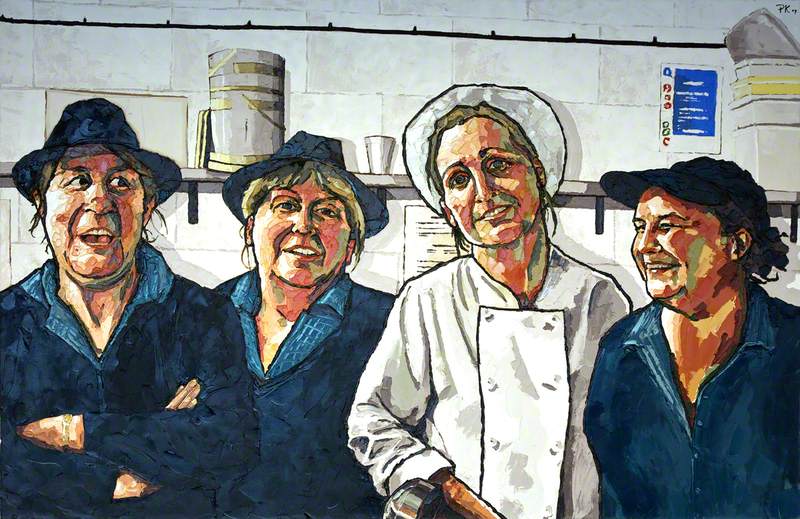
Dan took the opportunity to capture this photograph.

Conversations about how to make sure that art is representative of all people in different socio-economic strata of the population is certainly not new. However the unprecedented events of 2020, which have dismantled social structures and given rise to previously neglected conversations (seen most notably in the revived movement of Black Lives Movement), has ignited conversations about equality in all sectors of the arts.
Reflecting this shift, the Southbank Centre has announced the launch of 'Everyday Heroes', a project celebrating key workers through a series of outdoor art and poetry commissions.
Everyday Heroes
— Hayward Gallery (@haywardgallery) June 22, 2020
We’re delighted to announce a new public art and poetry project that celebrates and highlights the invaluable contributions of all those key workers who have kept the country running during the COVID-19 crisis.
Mid Aug - Nov 2020 https://t.co/NEUyzejkIt
In homage to those working on the frontlines during the COVID-19 crisis, the Centre will showcase portraits and poems across prominent public spaces and walkways in London, meaning it is accessible (and free) to all who live, or who can travel to London. Of course, the very fact that culture is often centered in London, and doesn't extend to regional areas of Britain, is another issue to be addressed.
Highlights include a portrait by Barbara Walker, who has painted her daughter (a nurse), as well as artist Ryan Mosley's painting of his brother, a train driver. More about the 'Everyday Heroes' project can be found on the Southbank Centre website, which is set to open at Hayward Gallery from mid-August to November 2020.
Lydia Figes, Content Editor at Art UK
